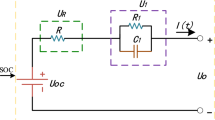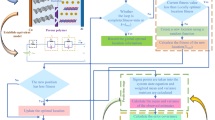Abstract
This paper proposes a novel approach to the power system dynamic state estimation by using the concepts of dynamic artificial neural networks and dual unscented Kalman filter. A dynamic artificial neural network is applied for developing a discrete-time state transition model of power system which is used for one-step-ahead prediction of the state vector. The model is also applicable for the generation of pseudo-measurements while it is needed. The dual unscented Kalman filter estimates the state vector of power system and calculates the weights of the dynamic artificial neural network simultaneously. A multi-agent-based model is utilized to structure the computational architecture of the proposed approach. The autonomous agents are designed to carry out the complex computations needed in the power system dynamic state estimation. The agents distribute multiple execution tasks among themselves, and they share information interactively. The agent-based modeling of the proposed method enhances the computing efficiency through decomposition of the computations among several autonomous agents. The effectiveness of the proposed method is examined through comprehensive simulations. The results guarantee the performance of the proposed approach as a practical solution for the power system dynamic state estimation.



















Similar content being viewed by others
Explore related subjects
Discover the latest articles, news and stories from top researchers in related subjects.References
Abur A, Exposito AG (2004) Power system state estimation: theory and implementation. CRC Press, Boca Raton
Ahmed NK, Atiya AF, Gayar NE, El-Shishiny H (2010) An empirical comparison of machine learning models for time series forecasting. Econ Rev 29:594–621
Aminifar F, Shahidehpour M, Fotuhi-Firuzabad M, Kamalinia S (2014) Power system dynamic state estimation with synchronized phasor measurements. IEEE Trans Instrum Meas 63:352–363
Bai J, Ng S (2005) Tests for skewness, kurtosis, and normality for time series data. J Bus Econ Stat 23:49–60
Bellifemine F et al (2002) Java agent development framework. TILAB Italia 10:2002
Bi T, Qin X, Yang Q (2008) A novel hybrid state estimator for including synchronized phasor measurements. Electr Power Syst Res 78:1343–1352
Blood E, Ilic M, Krogh BA (2006) Kalman filter approach to quasi-static state estimation in electric power systems. In: Power symposium, 2006. NAPS 2006. 38th North American, 2006. IEEE, pp 417–422
Bretas N (1989) An iterative dynamic state estimation and bad data processing. Int J Electr Power Energy Syst 11:70–74
Buitrago J, Asfour S (2017) Short-term forecasting of electric loads using nonlinear autoregressive artificial neural networks with exogenous vector inputs. Energies 10:40
Caro E, Valverde G (2014) Impact of transformer correlations in state estimation using the unscented transformation. IEEE Trans Power Syst 29:368–376
Cybenko G (1989) Approximation by superpositions of a sigmoidal function. Math Control Signals Systems 2:303–314
Dabbagchi I, Christie R (1993) Power system test case archive (resources at electrical engineering). The University of Washington, Seattle
Debs AS, Larson RE (1970) A dynamic estimator for tracking the state of a power system. IEEE Trans Power Appar Syst 7:1670–1678
Do Coutto Filho MB, de Souza JCS (2009) Forecasting-aided state estimation—part I: panorama. IEEE Trans Power Syst 24:1667–1677
Do Coutto Filho MB, de Souza JCS, Freund RS (2009) Forecasting-aided state estimation—part II: implementation. IEEE Trans Power Syst 24:1678–1685
Falcao DM, Wu FF, Murphy L (1995) Parallel and distributed state estimation. IEEE Trans Power Syst 10:724–730
Funahashi K-I (1989) On the approximate realization of continuous mappings by neural networks. Neural Netw 2:183–192
Ghahremani E, Kamwa I (2011) Online state estimation of a synchronous generator using unscented Kalman filter from phasor measurements units. IEEE Trans Energy Convers 26:1099–1108
Hagan MT, Demuth HB, Beale MH (1996) Neural network design, vol 20. Pws Pub., Boston
Haykin SS (2001) Kalman filtering and neural networks. Wiley, Hoboken
Iiguni Y, Sakai H, Tokumaru H (1992) A real-time learning algorithm for a multilayered neural network based on the extended Kalman filter. IEEE Trans Signal Process 40:959–966
Julier SJ, Uhlmann JK (1997) New extension of the Kalman filter to nonlinear systems. In: AeroSense’97, 1997. International society for optics and photonics, pp 182–193
Julier SJ, Uhlmann JK (2004) Unscented filtering and nonlinear estimation. Proc IEEE 92:401–422
Julier S, Uhlmann J, Durrant-Whyte HF (2000) A new method for the nonlinear transformation of means and covariances in filters and estimators. IEEE Trans Autom Control 45:477–482
Kirincic V, Skok S, Terzija V (2015) A two-step hybrid power system state estimator. Int Trans Electr Energy Syst 25:1158–1172
Ko C-N, Lee C-M (2013) Short-term load forecasting using SVR (support vector regression)-based radial basis function neural network with dual extended Kalman filter. Energy 49:413–422
Korres GN, Manousakis NM (2011) State estimation and bad data processing for systems including PMU and SCADA measurements. Electr Power Syst Res 81:1514–1524
Mandic DP, Chambers JA (2000) A normalised real time recurrent learning algorithm. Sig Process 80:1909–1916
McArthur SD, Davidson EM, Catterson VM, Dimeas AL, Hatziargyriou ND, Ponci F, Funabashi T (2007a) Multi-agent systems for power engineering applications—part I: concepts, approaches, and technical challenges. IEEE Trans Power Syst 22:1743–1752
McArthur SD, Davidson EM, Catterson VM, Dimeas AL, Hatziargyriou ND, Ponci F, Funabashi T (2007b) Multi-agent systems for power engineering applications—part II: technologies, standards, and tools for building multi-agent systems. IEEE Trans Power Syst 22:1753–1759
Nishiya K, Hasegawa J, Koike T (1982) Dynamic state estimation including anomaly detection and identification for power systems. In: IEE proceedings C (generation, transmission and distribution), 1982. vol 5. IET, pp 192–198
Nordman MM, Lehtonen M (2005) Distributed agent-based state estimation for electrical distribution networks. IEEE Trans Power Syst 20:652–658
Pai A (2012) Energy function analysis for power system stability. Springer, Berlin
Qi J, Sun K, Wang J, Liu H (2016) Dynamic state estimation for multi-machine power system by unscented Kalman filter with enhanced numerical stability. IEEE Trans Smart Grid 9(2):1184–1196
Sanderson C, Curtin R (2016) Armadillo: a template-based C ++ library for linear algebra. J Open Source Softw. https://doi.org/10.21105/joss.00026
Shahidehpour M, Wang Y (2004) Communication and control in electric power systems: applications of parallel and distributed processing. Wiley, Hoboken
Sinha A, Mondal J (1999) Dynamic state estimator using ANN based bus load prediction. IEEE Trans Power Syst 14:1219–1225
SpA T (2001) Foundation for intelligent physical agents
Srivastava A, Ravikumar KG, Zweigle G (2011) Wide-area monitoring and control using the real time digital simulator and a synchrophasor vector processor. Int Trans Electr Energy Syst 21:1521–1530
Talebi HA, Abdollahi F, Patel RV, Khorasani K (2009) Neural network-based state estimation of nonlinear systems: application to fault detection and isolation, vol 395. Springer, Berlin
Tsekouras GJ, Kanellos FD, Mastorakis N (2015) Short term load forecasting in electric power systems with artificial neural networks. In: Mastorakis N, Bulucea A, Tsekouras G (eds) Computational problems in science and engineering, Lecture Notes in Electrical Engineering, vol 343. Springer, Cham, pp 19–58
Valverde G, Terzija V (2011) Unscented Kalman filter for power system dynamic state estimation. IET Gener Transm Distrib 5:29–37
Volna E (2013) Introduction to soft computing (ISBN: 978-87-403-0391-9). https://Bookboon.com
Wan EA, Van Der Merwe R (2000) The unscented Kalman filter for nonlinear estimation. In: Adaptive systems for signal processing, communications, and control symposium 2000. AS-SPCC. The IEEE 2000, 2000. IEEE, pp 153–158
Wang S, Gao W, Meliopoulos AS (2012) An alternative method for power system dynamic state estimation based on unscented transform. IEEE Trans Power Syst 27:942–950
Wooldridge M (2009) An introduction to multiagent systems. Wiley, Hoboken
Zhan R, Wan J (2006) Neural network-aided adaptive unscented Kalman filter for nonlinear state estimation. IEEE Signal Process Lett 13:445–448
Zhao J (2017) Power system dynamic state estimation considering measurement correlations. IEEE Trans Energy Convers 32:1630–1632
Zhao J, Zhang G, La Scala M (2015) PMU based robust dynamic state estimation method for power systems. In: Power & energy society general meeting, 2015 IEEE, 2015. IEEE, pp 1–5
Zhao J, Zhang G, Das K, Korres GN, Manousakis NM, Sinha AK, He Z (2016) Power system real-time monitoring by using PMU-based robust state estimation method. IEEE Trans Smart Grid 7:300–309
Author information
Authors and Affiliations
Corresponding author
Ethics declarations
Conflict of interest
Authors declare that they have no conflict of interest.
Ethical approval
This article does not contain any studies with human participants or animals performed by any of the authors.
Additional information
Communicated by V. Loia.
Publisher's Note
Springer Nature remains neutral with regard to jurisdictional claims in published maps and institutional affiliations.
Rights and permissions
About this article
Cite this article
Goleijani, S., Ameli, M.T. An agent-based approach to power system dynamic state estimation through dual unscented Kalman filter and artificial neural network. Soft Comput 23, 12585–12606 (2019). https://doi.org/10.1007/s00500-019-03809-7
Published:
Issue Date:
DOI: https://doi.org/10.1007/s00500-019-03809-7




